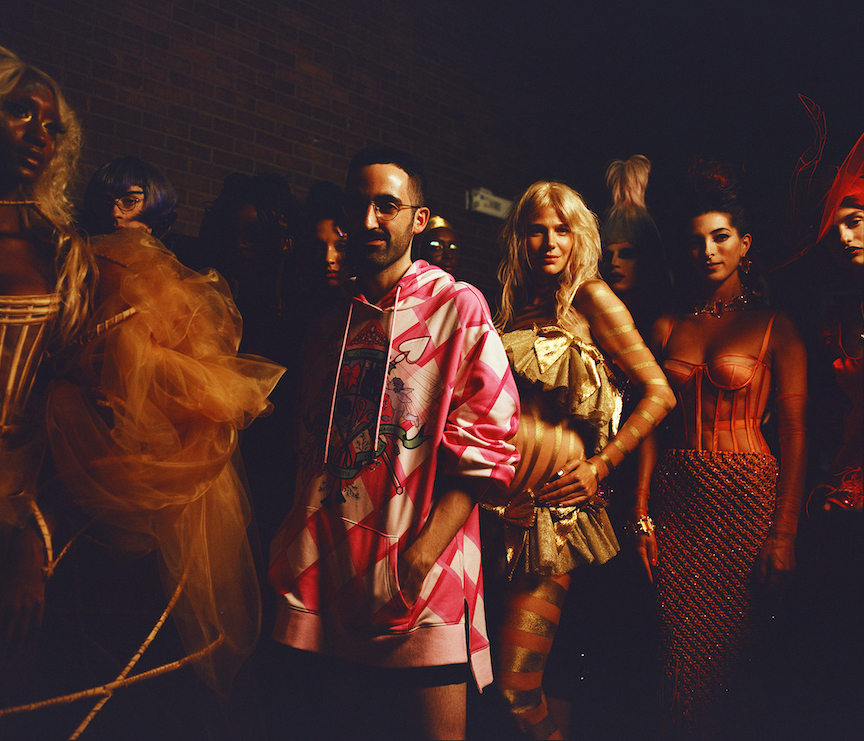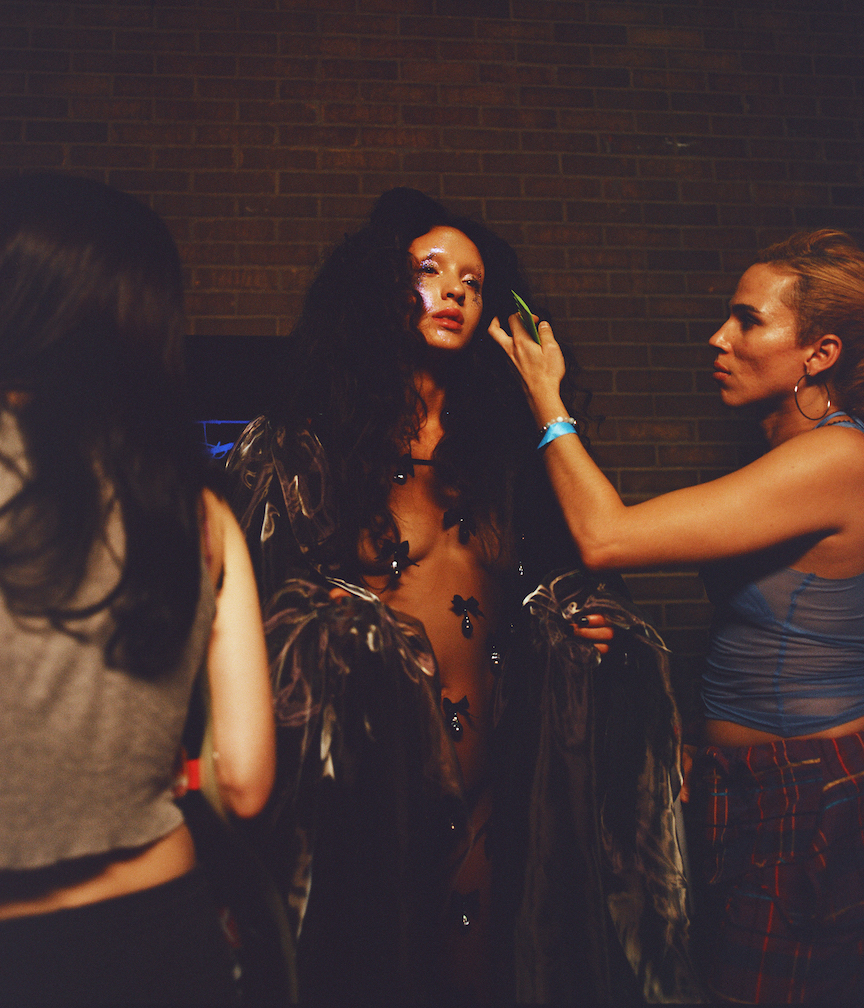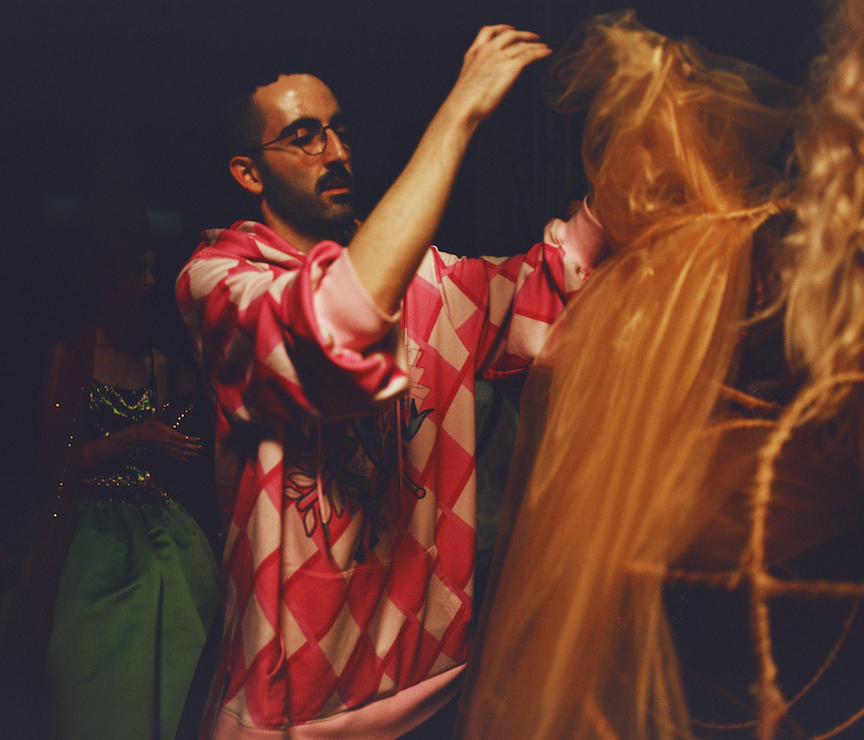New Guards: Wiederhoeft
Jackson Wiederhoeft sits down with V to discuss the whimsical ethos behind their brand, Spring/Summer 2023 runway debut, and path forward

This feature appears in V139, Supermodel, Superhero issue, now available for purchase.
Storytelling is at the epicenter of Jackson Wiederhoeft’s eponymous label Wiederhoeft. Their designs are poetic, weaving innate, couture-like craft with whimsical motifs and daring silhouettes. And since catapulting onto the scene in 2019, the designer has had quite the ride: a foray into bridal, a 2022 CFDA/Vogue Fashion Fund nomination, and most recently, a theatrical runway debut show for the Spring/Summer 2023 season.
Titled “The Spell,” the collection was split into five acts with each look named after an archetypal fairytale character—The Herald, The Bishop, The Knight. Looking to Medieval references as inspiration, the collection toyed with eclectic hues and technical shapes that showed off the designer’s bridal background.

“This dichotomy of feeling heartbreak and exponential joy at the same time is what it means to be alive,” Wiederhoeft explains. “I wanted the audience to feel and the music also spoke to this emotion of heartbreak and joy. It was definitely a full run of emotions throughout the whole show.”
And as a self-proclaimed theater nerd, the showcase contained all the hallmarks of a must-see production—dance, music, acting, and lots of drama. That spirited ethos is something that Widerhoeft carries throught their brand, which has quickly become a favorite amongst New York’s queer community.
Below, V caught up with Wiedehroeft to discuss the journey of their brand, most recent Spring/Summer collection, and why community is so vital in fashion.
V MAGAZINE: I wanted to start with your inspiration for the Spring/Summer season. Can you walk us through your process for the collection? Where did you start?
JACKSON WIEDERHOEFT: Some of the main things I looked at were Medieval artifacts. We spent some time at the MET looking at different kinds of armor, castles, creepy porcelain dolls, jewelry, gemstones, mosaics, and liturgical writings. But for me, as usual, I take in a lot of these shapes, colors, and silhouettes and try to reinterpret it in a way that brings some modernity to it.
V: And there was obviously a very theatrical feel to the show, with the opening and the ending portion. Can you walk us through your idea behind that? And as a viewer, there was a story throughout, can you elaborate on that narrative?
JW: It came down to a collection in five acts. So you have, Act One [which] I wanted to give the audience a lot of time—it was three minutes of watching these two girls do their runway and enter the playground. So for me, the collection is called “The Spell” and it has to do with, in a sense, the spell they’re casting. Act One is them creating this world together and Act Two, the runway section, is the actual enchantment itself—like when you’re a child and your imagination is almost like a hallucination.
I wanted to play with that idea of: something that’s not real is more real than something that is—this fabrication or creativity is more powerful than the truth, that subjective versus objective point of view. So we see the runway show and every look has a character named after it: Look One is The Herald, you have The Bishop, The Knight. They’re all this very archetypal fairytale, which I wanted to play with. Like I mentioned with the Medieval inspiration, I was looking at archetypes and trying to strip away some of that context and really focus on the formalistic qualities.
And then Act Three was called The Specter Temptation: the show ends and [with] the progression of the looks, you start with something really joyful, like The Herald, you have The Princess, you have The Prince, all of these really bubbly looks. And then it goes into slightly darker looks like The Dungeon, The Executioner, things that feel a little more aggressive. The movement that’s happening the whole time with the two girls in the middle, it actually does start to get more aggressive toward the end where it’s this feeling of best friends fighting. Which is ultimately the reasoning behind the show ending, the spell is broken [similar] to when you’re a kid and you’re at a slumber party and you’ve stayed awake too long and suddenly you’re fighting with your best friend and the magic is over.

And that’s when The Specs, which are like the dark ideas come in. And for me that’s kind of a representation of every dark idea, every dark thought, as a child [but] as an adult, I think we encountered them more often. And the idea for me was that the collection started from a point of view of thinking of myself as the girls in that way. I feel like when you’re working in a creative field, it’s easy to feel like you’re in your colorful little fantasy and nothing really matters. And those fun ideas keep the dark thoughts at bay, but sometimes in those moments of darkness, they’re coming closer than ever.
So the movement there indicates that one girl chooses the darkness and one girl doesn’t. And that leads us into Act Four, which is the girl who stayed behind to find herself alone and she starts to dance again and revisit some of these motions that she was creating in Act One and two, but by herself. And then we see the finale look, which we call The Bright Idea, which is this big gold dress that walks the runway by itself and the thought is that one bright idea is all you need to save you—there’s big power in that creative thought, but also the fragility of sometimes all you have is one good idea and there’s four dark ideas.
Also the feeling of joy and desolation simultaneously—people get hurt, friends die, so many dark things happen, but also beautiful things happen simultaneously. This dichotomy of feeling heartbreak and exponential joy at the same time is what it means to be alive, you know? I wanted the audience to feel and the music also spoke to this emotion of heartbreak and joy. And Act Five is the finale walk where you see all the looks together and it’s more triumphant. It was definitely a full run of emotions throughout the whole show.
V: And as this was your first runway show, what were your emotions beforehand? And what was it like to have this stage to bring the collection to life?
JW: There’s something about the runway that’s just very intoxicating and I think it is what got so many of us into fashion. And, regardless, is it the most effective way to reach a wide audience? Definitely not, but there is a performative aspect, and as someone who’s a theater nerd, that’s what a fashion show is. It is theater, it is art, but it’s also seeing it come to life and walk in this way, there’s nothing better. There’s nothing like it in the world. And seeing a model walk in the look in front of you in a venue with music, with lights, it’s theater. And for me, the perfect intersection of theater and fashion exists in the runway show. So now we’re at a point where the runway show—it’s not the 1920s where you’d gather all your buyers together and here’s look one, look, two, look three—we have the internet, we don’t need it.
But it serves just as crucial a role in expressing an emotion and creating a sense of the brand and this world. So for me, this was all about taking advantage of that. Having people in a room, having an audience in that very theatrical kind of way. So much of what I do is about emotion, it’s about storytelling. I felt really excited, we haven’t done anything since COVID in-person. And so much of what I do is very emotional, the clothes are very detailed, and it felt like the main objective here was to show people this is what we can do and this is what I want to do. This is where the brand can exist in New York and within fashion. I’m really happy for the opportunity to have done that, and the emotions spoke to a lot of people.
V: Independent brands are having a moment in New York fashion. You have such a community and team around yourself and your brand, what importance does that bond play in helping to move to the next stage with your brand?
JW: Without the community, what is there? I’m really lucky to have worked with a lot of the same people from day one. Austin Goodwin, who does the choreography, and Sean Bennett, who does the hair. Even some of the models like Leslie, Andrea, William, she’s a principal dancer for Martha Graham and she danced in my first show. She’s been in two other collections. She danced in this show—all boats rise with the tides and I’m really happy with how much progress we’ve made in three years. But we share that together, every success is cumulative because so many people have contributed to it. And that’s what I love about fashion too, as it is one of the most collaborative art forms in the world.
There’s so many people that have contributed to the brand. I wanted to make a playbill for this collection, when you go to a Broadway show and it’s the little biographies. And that’s really important and something that, as time goes on, I want to get more involved in theater and film. I feel like in those industries, it’s even more prevalent as far as community
Also as a Capricorn, my love language is employment. And I love being able to be an employer, especially within the LGBTQ+ community where people aren’t always employed as they should be or paid what they should be—not that I can pay everyone’s full rate all the time—but to be able to pay a rate, to work with people who I know that money is going into, to the communities that I believe so strongly in that are sometimes underserved, that means a lot to me as well. It’s a “put your money where your mouth is” situation. And it’s a real privilege to be able to give back in some way.
And when other people are able to support themselves, that can build their businesses. Smith and Maki, they run Queens Design Team, they designed my showroom and that was their first project for their business. And now they’ve grown a business and they employ other people within this trans-led interior design firm. It’s really cool to be able to be in this community where everyone’s growing together. I’ve depended on so many people to get me where I am and now I can help other people fulfill their dreams. It’s all a cycle.
V: And to finish off, what is next for you? What is next for your brand?
JW: I loved doing a fashion show, we’ll see what happens next time. It’s very expensive, but it’s definitely very enjoyable. We have our bridal business that is doing quite well and I’ve really enjoyed working on that. So I’m thinking of how to incorporate bridal into this world in a way that feels just as punked up and contemporary as everything else, you know? I’m working on a design and costume for a film that we’re starting to work on that I’m excited about. Just trying to figure out what’s next. And of course, the day after the show, I’m sketching for the next season. But I also wanna make sure that products from this collection can actually exist because a lot of our sales up until now have been through our bridal business, which means that a lot of the products aren’t even available for sale because we don’t really get these orders from stores.
Now, I’m just ready to stop waiting for approval from some of these stores. I feel like I’ve been waiting for other people to approve and it’s silly, you know? Whereas the moments I’m the most proud of are when I feel like I just do it. I’m excited to start having more of our direct to consumer and e-commerce business for products that people want outside of bridal. There’s a million things I wanna do.

Discover More
